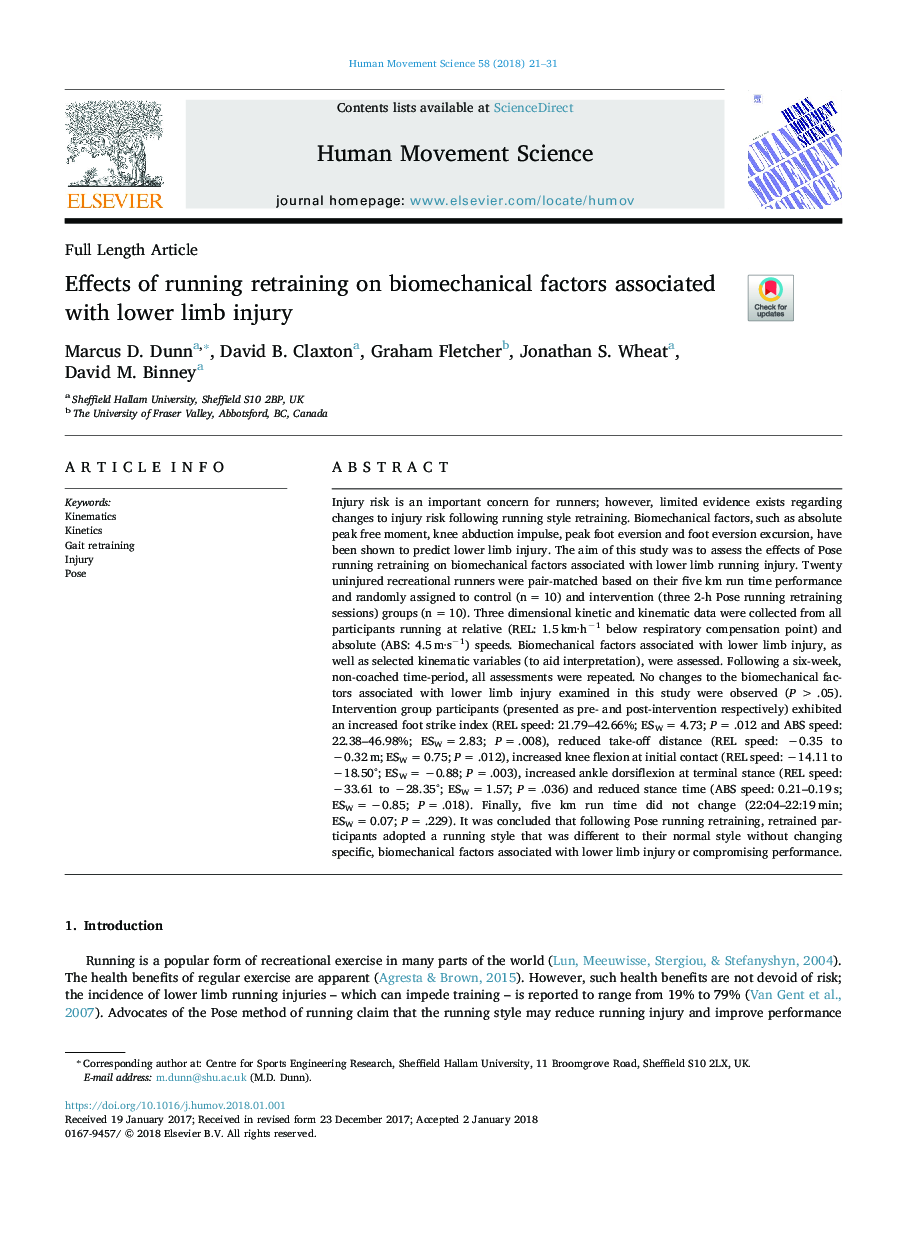| کد مقاله | کد نشریه | سال انتشار | مقاله انگلیسی | نسخه تمام متن |
|---|---|---|---|---|
| 7290907 | 1474206 | 2018 | 11 صفحه PDF | دانلود رایگان |
عنوان انگلیسی مقاله ISI
Effects of running retraining on biomechanical factors associated with lower limb injury
ترجمه فارسی عنوان
تأثیر بازآموزی در حال اجرا بر عوامل بیومکانیک مرتبط با آسیب اندام تحتانی
دانلود مقاله + سفارش ترجمه
دانلود مقاله ISI انگلیسی
رایگان برای ایرانیان
کلمات کلیدی
موضوعات مرتبط
علوم زیستی و بیوفناوری
علم عصب شناسی
علوم اعصاب شناختی
چکیده انگلیسی
Injury risk is an important concern for runners; however, limited evidence exists regarding changes to injury risk following running style retraining. Biomechanical factors, such as absolute peak free moment, knee abduction impulse, peak foot eversion and foot eversion excursion, have been shown to predict lower limb injury. The aim of this study was to assess the effects of Pose running retraining on biomechanical factors associated with lower limb running injury. Twenty uninjured recreational runners were pair-matched based on their five km run time performance and randomly assigned to control (nâ¯=â¯10) and intervention (three 2-h Pose running retraining sessions) groups (nâ¯=â¯10). Three dimensional kinetic and kinematic data were collected from all participants running at relative (REL: 1.5â¯km·hâ1 below respiratory compensation point) and absolute (ABS: 4.5â¯m·sâ1) speeds. Biomechanical factors associated with lower limb injury, as well as selected kinematic variables (to aid interpretation), were assessed. Following a six-week, non-coached time-period, all assessments were repeated. No changes to the biomechanical factors associated with lower limb injury examined in this study were observed (Pâ¯>â¯.05). Intervention group participants (presented as pre- and post-intervention respectively) exhibited an increased foot strike index (REL speed: 21.79-42.66%; ESWâ¯=â¯4.73; Pâ¯=â¯.012 and ABS speed: 22.38-46.98%; ESWâ¯=â¯2.83; Pâ¯=â¯.008), reduced take-off distance (REL speed: â0.35 to â0.32â¯m; ESWâ¯=â¯0.75; Pâ¯=â¯.012), increased knee flexion at initial contact (REL speed: â14.11 to â18.50°; ESWâ¯=â¯â0.88; Pâ¯=â¯.003), increased ankle dorsiflexion at terminal stance (REL speed: â33.61 to â28.35°; ESWâ¯=â¯1.57; Pâ¯=â¯.036) and reduced stance time (ABS speed: 0.21-0.19â¯s; ESWâ¯=â¯â0.85; Pâ¯=â¯.018). Finally, five km run time did not change (22:04-22:19â¯min; ESWâ¯=â¯0.07; Pâ¯=â¯.229). It was concluded that following Pose running retraining, retrained participants adopted a running style that was different to their normal style without changing specific, biomechanical factors associated with lower limb injury or compromising performance.
ناشر
Database: Elsevier - ScienceDirect (ساینس دایرکت)
Journal: Human Movement Science - Volume 58, April 2018, Pages 21-31
Journal: Human Movement Science - Volume 58, April 2018, Pages 21-31
نویسندگان
Marcus D. Dunn, David B. Claxton, Graham Fletcher, Jonathan S. Wheat, David M. Binney,
